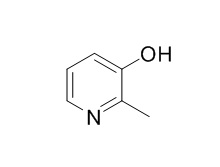3-Hydroxy-2-methylpyridine
3-Hydroxy-2-methylpyridine could as a promising molecular scaffold for the future development of novel fibrillization inhibitors.
Inquire / Order:
manager@chemfaces.com
Technical Inquiries:
service@chemfaces.com
Tel:
+86-27-84237783
Fax:
+86-27-84254680
Address:
1 Building, No. 83, CheCheng Rd., Wuhan Economic and Technological Development Zone, Wuhan, Hubei 430056, PRC
Providing storage is as stated on the product vial and the vial is kept tightly sealed, the product can be stored for up to
24 months(2-8C).
Wherever possible, you should prepare and use solutions on the same day. However, if you need to make up stock solutions in advance, we recommend that you store the solution as aliquots in tightly sealed vials at -20C. Generally, these will be useable for up to two weeks. Before use, and prior to opening the vial we recommend that you allow your product to equilibrate to room temperature for at least 1 hour.
Need more advice on solubility, usage and handling? Please email to: service@chemfaces.com
The packaging of the product may have turned upside down during transportation, resulting in the natural compounds adhering to the neck or cap of the vial. take the vial out of its packaging and gently shake to let the compounds fall to the bottom of the vial. for liquid products, centrifuge at 200-500 RPM to gather the liquid at the bottom of the vial. try to avoid loss or contamination during handling.
J of Engineering Science&Technology2018, 13(9):2820-2828
Asian Pac J Cancer Prev. 2020, 21(4):935-941.
Mol Pharmacol.2021, 99(2):163-174.
Biomed Pharmacother.2024, 176:116765.
Molecules2022, 27(9):2992.
J Nat Prod.2018, 81(4):966-975
Internoational J of Toxicology2020, 10.1177.
J Lipid Res.2024, 65(10):100640.
Int. J. of Pha. and Phy. Res.2015, 7(1):144-149
Molecules.2023, 28(9):3685.
Related and Featured Products
Sci Rep. 2015 Jul 14;5:12052.
Ortho-methylated 3-hydroxypyridines hinder hen egg-white lysozyme fibrillogenesis.[Pubmed:
26169912 ]
Protein aggregation with the concomitant formation of amyloid fibrils is related to several neurodegenerative diseases, but also to non-neuropathic amyloidogenic diseases and non-neurophatic systemic amyloidosis. Lysozyme is the protein involved in the latter, and it is widely used as a model system to study the mechanisms underlying fibril formation and its inhibition. Several phenolic compounds have been reported as inhibitors of fibril formation. However, the anti-aggregating capacity of other heteroaromatic compounds has not been studied in any depth.
METHODS AND RESULTS:
We have screened the capacity of eleven different hydroxypyridines to affect the acid-induced fibrillization of hen lysozyme. Although most of the tested hydroxypyridines alter the fibrillation kinetics of HEWL, only 3-Hydroxy-2-methylpyridine, 3-hydroxy-6-methylpyridine and 3-hydroxy-2,6-dimethylpyridine completely abolish fibril formation. Different biophysical techniques and several theoretical approaches are combined to elucidate their mechanism of action. O-methylated 3-hydroxypyridines bind non-cooperatively to two distinct but amyloidogenic regions of monomeric lysozyme. This stabilises the protein structure, as evidenced by enhanced thermal stability, and results in the inhibition of the conformational transition that precedes fibril assembly.
CONCLUSIONS:
Our results point to o-methylated 3-hydroxypyridines as a promising molecular scaffold for the future development of novel fibrillization inhibitors.



